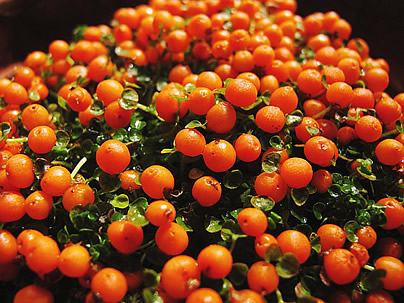The Coral Bead Plant (Nertera granadensis) is a herbaceous, perennial, and creeping plant, forming small, compact, and rounded clumps suitable for ground cover or as a pot plant. It originates from various regions bathed by the Pacific Ocean, including countries in Asia, Oceania, and the Americas. Its leaves are tiny, succulent, and rounded, with a bright green and glabrous color, emerging from thin, quadrangular, branched, and prostrate twigs that emit new roots from the nodes if in contact with the substrate. The adult plant’s height is usually between 2 to 3 inches (approximately 5 to 8 cm), with a diameter of about 20 inches (nearly 50 cm).
The flowers of the coral bead plant appear in spring and are discreet, white, and tiny, with little ornamental importance. By the end of summer, the plant is covered with small, spherical, durable, and shiny fruits of the berry type, in red, coral, or orange colors, depending on the variety. These little fruits give the plant a very graceful and decorative appearance, reminiscent of a pin-cushioned cushion.
This curious and beautiful plant is recommended only for more experienced gardeners due to its requirements. However, those daring to grow the coral bead plant can be rewarded with at least three months of lush fruiting. It is more common, however – despite being a novelty in the Brazilian market, to find it for sale already covered with fruits and thus decorate the home for some time, without worrying much about cultivation, in the same way as other potted flowers, like gerberas, violets, and cyclamens.
In the United States, the coral bead plant is especially sought after during Halloween for interior decoration. But it can also be used in the garden as ground cover, if it adapts well to the location. It is ideal for rock gardens, accompanying cacti and succulents, but with higher humidity requirements.
It should be cultivated in partial shade or diffuse light, in a substrate with good moisture retention capacity, yet airy and drainable. Substrate mixtures containing garden soil, peat, vermiculite, rice husk, or coconut fiber can be interesting. The coral bead plant appreciates humidity in the environment and the substrate, but excess water can cause irreversible rot. Keep the plant in a ventilated place, without drafts, and where it can get morning or late afternoon sun. Water well and wait for it to dry out slightly between watering.
In dry places, it may be necessary to supplement humidity with humidifiers or by placing a tray with stones and water under the pot, especially during flowering. Reduce watering in winter. It does not tolerate extreme heat or cold. It dislikes being disturbed, turned, or moved. It prefers a cool climate, with an ideal temperature range of 50 to 59°F (10 to 15°C). If temperatures exceed 64°F (18°C) during flowering, it will not bear fruit.
Fertilize the coral bead plant with fertilizers suitable for flowering during the blooming and fruiting periods, diluted to half strength and once a month. Carefully remove the darkened fruits for a better appearance of the plant. It multiplies by seeds, harvested from well-ripened fruits and sown in spring, in the dark – so cover the seeds well. It germinates between 20 and 25 days. It also propagates by division of the rooted branches and by cuttings.


